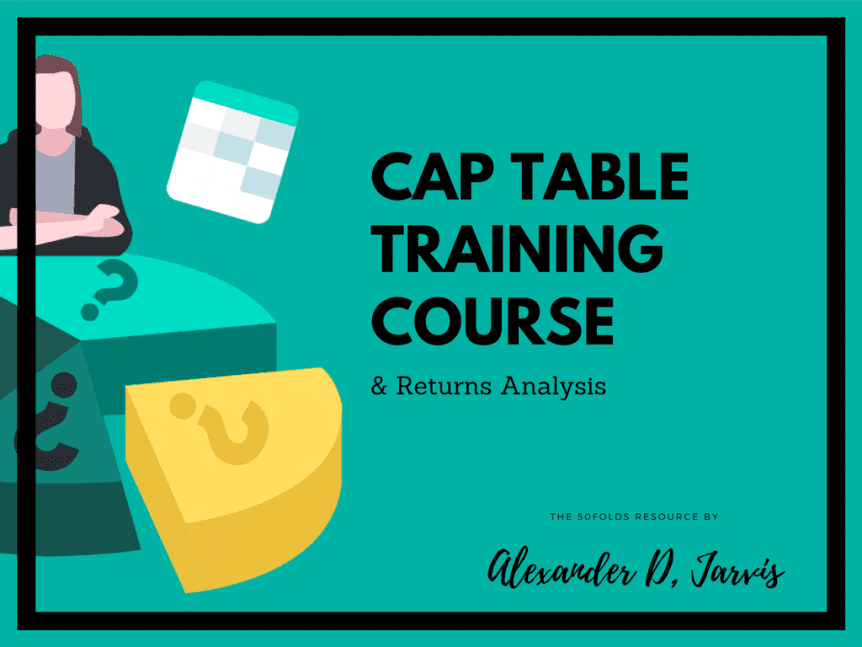This is the 7th part of the Pro Cap Table training course on the cap table sheet. In this series we go through the basics you need to know, then work sheet by sheet so you know how to make a seriously kick ass cap table.
There are 14 parts:
- What is a cap table and other important questions
- Cap table dilution step by step example
- Cap table dilution math
- Starting the cap table (The drop down menus we need)
- Shareholders sheet
- Deal calculations
- The cap table sheet
- The assumptions sheet
- Individual shareholder returns sheet
- Returns waterfall calculation
- The ESOP sheet
- The Common sheet
- The convertible notes and warrants sheet
- The preference shares sheets (From Series A to I)
You can join the course and get these sent straight to your mail box here:
The cap table sheet is what you want to see. It’s the result of all the work in this model. The super thing about it is that it is almost entirely automated and there are very few inputs (3 max!).
The Pro Cap Table is fully integrated- everything is connected. So long as you input things correctly, this is amazeballs.
What do you need to do to make the cap table sheet work?
You see the orangey boxes? That’s where you click and add the name of each shareholder. You can see that 8 are added here. You can also see what class of stock each investor owns, as well as the totals.
Just add the names you need at each round. Check the shareholder sheet and make sure you have them in it. This is your common sheet.

Now you do a fundraise for your series-a class of stock. To update this you just add the S-A shareholders. These are your 2 convertible holders, your warrant holder and your S-A investor. Add three new names.
You’re now done for this round. Sort of.
Perhaps your investors have major rights? Then click ‘Yes’ in the drop down menu.
At your S-B you now know if your investors are going to call on their major rights and ‘Participate.’ That means they want to do their pro rata. Click Yes on the fellas and you are done.

What about S-B, C, D… I?
Same thing. That’s all you need to do.
But let’s have a look at your S-I. There’s more shareholders and more rows and columns… but still one set of inputs. A whole lot of outputs with little inputs.
Each column shows the shares held per class of stock. These all add up to the total.
You need to know the ownership by class of stock where there are voting decisions, but ultimately the relative ownership position is what matters. This shows this.

At the bottom of each cap table are some checks. When you see ‘OK’ everywhere you know things are cool!
Now to look at more of the details:
- At the top of each sheet is the date of the transaction closing
- Under the orange boxes are ‘plugs.’ These illustrate if there are any errors or rounding errors. They are also used when you want to forecast a scenario. You can see the rounds G, H and I have shares in the plugs. If you want to get rid of those rounds, all you need to do is remove them from the assumptions page
- After the Series-I are options and warrants. These are not actual shares (yet). Total outstanding is the sum of common and the preference shares. Full diluted includes the options and warrants. The fully diluted assume the options and warrants are on a ‘as converted’ basis
- After the plugs you have a subtotal. This adds up each column
- You then have reserved options. There is one number fed in which is the total issued options, less the total number of options (adjusted for exercise, cancellation and expiration) as of the day before the date of the transaction
It’s important to note that the whole model is time dependent. Every change that you make has a date on it and that change is accounted for. The model works such that up until the day prior to changes are represented up until the day before a transaction. So if someone is fired and their shares are clawed back the day before a transaction, they will go back to the ESOP pool.
If you don’t have the model yet, get it here.
Click here to continue
The assumptions sheetShow off to your friends. Hit a social button to share the cap table love!


Comments 2
Hey Alex,
Luv the hardwork on all these Table! Simply magic my friend 😀
Question: If I have a Founder that also has put up a Convertible Note.
Can I add him from the drop down menu under his orig name in the Notes tab or Should I make a new shareholder (in Shareholder tab) for the Founder/ Convertible note holder and keep them separate?
Thanks Again!
Author
Cheers mate.
I built for single entry investor, but I built this years ago. I would have done something logical.
You prob just have to do double ledger accounting.
I made videos. Do what they say.
If you want me to go through excel and tell figure out for you…